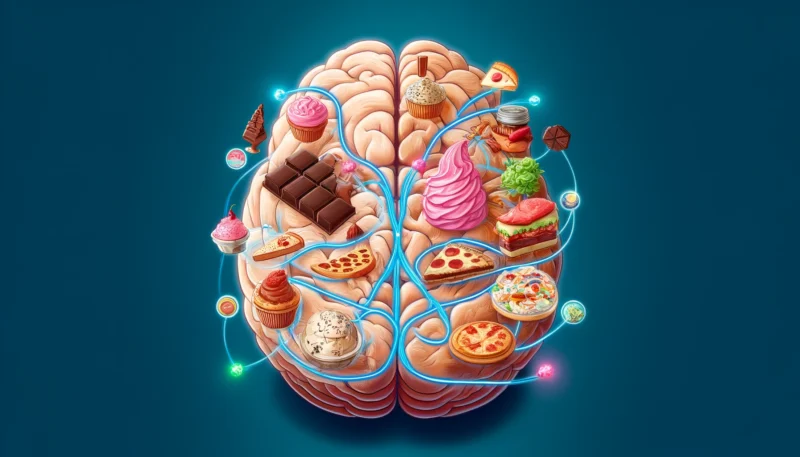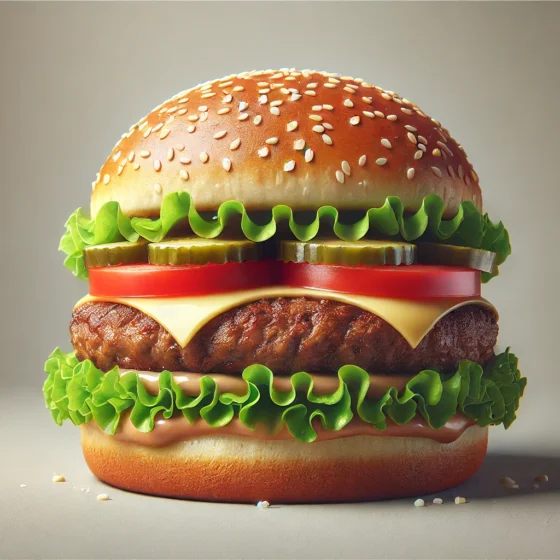In the whirlwind of daily life, food cravings emerge as powerful forces that sway even the most disciplined among us, guiding decisions toward comfort foods, binge eating, and sometimes to what feels like food addiction. Understanding the science behind why we experience food cravings, alongside the food industry’s role in shaping these desires, is essential for grappling with modern dietary challenges. The quest to manage these urges intersects with various aspects of health, including emotional well-being and stress eating, highlighting the importance of comprehending the complex nature of food cravings meaning, what causes cravings, and why am I craving food so much.
This article delves into the multifaceted world of food cravings, beginning with an exploration of the basic concept and the pivotal role the brain plays in these experiences. It scrutinizes factors influencing cravings, investigating why we have cravings for certain foods over others and the counterintuitive impact of restricting food intake on these cravings. Further, it offers strategies on how to stop food cravings, addressing the relationship between dieting, emotional eating, and cravings. Through an academic lens, the narrative provides valuable insights into managing food habits, underscoring the significance of recognizing and addressing the reasons why do we get cravings, paving the way for a balanced approach to food and wellness.
Understanding Cravings: The Basic Concept
A food craving is characterized by an intense desire to consume a specific type of food. This desire is not only strong but can often feel uncontrollable, leading individuals towards typically unhealthy food choices such as high-sugar, high-salt, and high-fat processed foods. These cravings are extremely common and manifest differently across individuals, yet they share a commonality in their transient nature and tendency towards processed foods.
Differentiating Cravings from Hunger
Cravings and hunger are distinct experiences, with hunger being the physiological need for food intake due to an empty stomach, whereas cravings are specific and intense desires for particular foods. Hunger can be satisfied by consuming any food, but cravings are usually only quenched by eating the specific food that one is craving. It’s crucial to note that one does not need to be hungry to experience food cravings, indicating that cravings can occur independently of hunger.
The Role of the Brain and Hormones
The brain plays a pivotal role in the experience of food cravings, with specific regions associated with memory, pleasure, and reward being involved. An imbalance in hormones such as leptin and serotonin is also thought to contribute to the development of food cravings. These cravings are not just about the physiological aspects but also involve the brain’s appetite centers, highlighting a complex interaction between various bodily systems.
Physical and Mental Factors
Food cravings can be triggered by a multitude of factors, which can be broadly categorized into physical and mental. Physical factors might include hormonal fluctuations, such as those experienced during menstruation or pregnancy, which can intensify cravings. On the mental side, emotions play a significant role, with comfort eating being a common response to emotional distress. Additionally, the body’s need for specific nutrients may sometimes manifest as cravings, although this is less commonly supported by scientific evidence.
External and Internal Cues
External cues, such as seeing a favorite snack while watching TV, can condition individuals to crave that food in similar future contexts. Internal cues, including emotional states like sadness, can also prompt cravings. Interestingly, food deprivation and dieting can exacerbate cravings, as can factors like poor sleep and one’s social environment, which continually expose individuals to tempting foods.
Types of Cravings
Cravings can be selective or nonselective. Selective cravings are desires for specific foods, such as a particular brand of chocolate or a specific flavor of chips. Nonselective hunger, on the other hand, is a more generalized desire to eat and may sometimes be a signal of real hunger or even thirst. Addressing nonselective cravings can sometimes be as simple as drinking water.
Understanding the basic concept of food cravings involves recognizing the multifaceted nature of these desires, which are influenced by a complex interplay of physiological, psychological, and environmental factors. By distinguishing cravings from hunger and acknowledging the various triggers and types of cravings, individuals can better navigate their experiences with food cravings.

The Role of the Brain in Food Cravings
The Role of the Brain in Food Cravings delves into the intricate mechanisms that govern our desires for specific foods. This exploration is crucial for understanding the psychological and physiological underpinnings of food cravings, which can significantly impact our eating behaviors and overall health.
The Neurobiology of Cravings
Cravings are a form of “food cue reactivity,” characterized by conditioned responses to food cues, leading to experiential, physiological, and neural responses. These reactions are particularly strong towards highly palatable, energy-dense foods, which are often the subject of our cravings. A seminal study employing functional magnetic resonance imaging (fMRI) revealed that food cravings activate the hippocampus, insula, and caudate regions of the brain, which are also implicated in drug cravings. However, it’s important to note that activation in these brain reward substrates is normal and can be observed in response to benign pleasurable stimuli, such as music, indicating that such brain activation does not necessarily imply addiction.
Reward Regions Activation and Association
The brain’s reward system plays a pivotal role in the development and persistence of food cravings. Foods that stimulate the reward regions of the brain, particularly those labeled as “hyperpalatable” due to their sweetness, saltiness, or richness, can significantly influence our food choices and eating behaviors. These foods can trigger the release of various hormones, including insulin, cortisol, dopamine, leptin, and ghrelin, all of which are implicated in the craving process. The repeated consumption of hyperpalatable foods can lead to changes in brain signaling and a decreased response of the reward system, necessitating the consumption of larger amounts of these foods to achieve the same reward response, a phenomenon similar to tolerance seen in drug or alcohol addiction.
Distinguishing Cravings from Hunger
Understanding the difference between cravings and hunger is crucial for managing eating behaviors effectively. Hunger is a gradual sensation that signals the body’s need for food and can be satisfied by eating any food. In contrast, cravings are sudden, intense desires for specific foods and are often associated with specific emotions such as stress, boredom, or sadness. Cravings can occur even when we are not physically hungry, highlighting their psychological rather than physiological basis. Recognizing and distinguishing these sensations can help individuals make healthier food choices and manage their cravings more effectively.
In summary, the role of the brain in food cravings encompasses a complex interplay of neural and hormonal responses to food cues, particularly in relation to hyperpalatable foods. Understanding these mechanisms is essential for developing strategies to manage cravings and promote healthier eating habits.

Factors Influencing Cravings
Emotional Triggers
Emotions significantly impact food cravings, with stress and emotional eating being prominent factors. Individuals often turn to food for comfort during emotional distress, leading to cravings for high-calorie, sweet, and fatty foods. Stress not only prompts emotional eating but may also result in weight gain independently of food cravings due to elevated cortisol levels, a stress hormone associated with abdominal fat accumulation. The act of emotional eating, aimed at suppressing or soothing negative emotions like stress, anger, fear, boredom, sadness, and loneliness, can disrupt weight-loss efforts and establish an unhealthy cycle of overeating.
Biological and Lifestyle Factors
Several biological and lifestyle factors contribute to food cravings. Hunger and thirst share similar sensations, which can lead to confusion between the two, with hydration shown to reduce food cravings. Additionally, sleep deprivation is linked to increased hunger and cravings for calorie-dense, high-carbohydrate foods. Adequate sleep, on the other hand, can help balance hormones and reduce cravings. Regular exercise also plays a role in managing cravings by affecting appetite-regulating hormones. Incorporating foods high in fiber, protein, and healthy fats into one’s diet can increase satiety and reduce cravings.
Sleep Deprivation and Hydration
Lack of sleep disrupts the brain’s reward system and increases cravings for high-calorie foods, a phenomenon correlated with the subjective severity of sleep deprivation. Sleep deprivation affects the olfactory system, making fatty and sweet foods more tempting by influencing the same neural pathway as marijuana does. This results in sleep-deprived individuals choosing higher calorie foods without necessarily feeling hungrier. Hydration is also crucial, as drinking water can help increase fullness and reduce cravings.
Environmental and Social Cues
Environmental and situational cues significantly influence food intake and cravings. Seeing, smelling, or hearing about specific foods can trigger cravings. For instance, advertisements for chocolate can induce a craving for it. Social settings and the presence of food-related media, such as television cooking shows or social media posts about food, can also stimulate cravings. Limiting exposure to these cues and forming new habits, such as choosing different routes to avoid fast food outlets, can help manage cravings.
In summary, managing food cravings involves understanding the complex interplay of emotional, biological, lifestyle, and environmental factors. Recognizing these triggers and adopting strategies to mitigate their impact can aid in controlling cravings and promoting healthier eating habits.

Why Do We Crave Certain Foods Over Others?
Familiarity with Specific Foods
Cravings often stem from the brain’s association of certain foods with specific memories or emotions. For instance, the desire for a particular type of ice cream might be linked to childhood experiences of receiving it as a treat. This association activates the brain’s reward system, reinforcing the craving each time the context or emotional state is revisited.
Hyperpalatable Foods and Their Appeal
Hyperpalatable foods are engineered to be irresistibly appealing, combining optimal levels of sugar, fat, and salt to stimulate the brain’s reward centers. Consuming these foods triggers a release of dopamine, a neurotransmitter associated with pleasure. Over time, this can lead to habitual cravings as the brain seeks to replicate the pleasurable experience. Foods that are high in these elements can disrupt normal hormonal signals related to hunger and satisfaction, leading to a cycle where the body craves more despite sufficient caloric intake.
Conditioning and Habitual Responses
Cravings can also develop through conditioning, where the consumption of certain foods becomes a learned response to specific stimuli or emotional states. For example, eating popcorn during a movie can become a conditioned behavior, prompting cravings for popcorn whenever a movie is watched. This type of conditioning can extend to emotional states as well, where certain foods are consumed as a response to stress or sadness, reinforcing the craving each time the emotional state occurs.
Understanding these factors—familiarity, hyperpalatability, and conditioning—provides insight into why we crave certain foods more than others. Recognizing these triggers is the first step in managing unhealthy eating patterns and making more mindful food choices.
The Impact of Restricting Food Intake on Cravings
Selective Food Deprivation
Experimental studies have demonstrated that short-term, selective food deprivation can indeed increase cravings for the avoided foods. This increase in cravings is observed across various food types, including chocolate-containing foods, with deprivation periods ranging from 1 day to 14 days, primarily among university students. These findings suggest that the psychological mechanisms play a significant role in the emergence of food cravings, as the selective food deprivation instructions are unlikely to have created a nutrient deficiency.
Caloric Restriction and Its Effects
In contrast to selective food deprivation, long-term energy restriction, often part of weight-loss interventions, results in a reduction of food cravings in overweight adults. This is supported by a meta-analysis by Kahathuduwa and colleagues, which investigated eight studies where caloric restriction was used as part of a weight-loss intervention, finding that food cravings actually decrease from pre- to post-intervention. Recent studies between 2017 and 2020, not included in the meta-analysis, corroborate these findings, showing a decrease in food cravings during the caloric restriction period across overweight or obese adults, with one study also including normal-weight participants. These results suggest that decreases in food cravings during caloric restriction may be due to the extinction of previously acquired conditioned responses.
Long-term Versus Short-Term Deprivation
The distinction between long-term and short-term food deprivation is crucial in understanding their impact on cravings. While short-term, selective food deprivation may increase cravings, long-term energy restriction appears to decrease them. This indicates that food deprivation can also facilitate the extinction of conditioned food responses. Extended calorie restriction, lasting at least 12 weeks, is associated with reductions in overall food cravings and cravings for specific types of food such as sweet food, high-fat food, starchy food, and fast food. These findings do not support the notion that food cravings occur due to a deficiency of energy or nutrients, contradicting the deficit theory. Instead, they support the alternate explanation that craving develops as a result of a conditioned association between repeated consumption of a specific type of food with a particular stimulus, environment, or occasion. Dietary calorie restriction interventions limit the consumption of energy-dense food while maintaining exposure to stimuli, environments, and occasions previously associated with consumption of specific types of food, potentially leading to reductions of overall food cravings and cravings for energy-dense food.
In summary, the impact of restricting food intake on cravings is nuanced, with short-term deprivation potentially increasing cravings due to psychological factors, while long-term restriction, especially when part of a structured weight-loss intervention, appears to decrease cravings through the extinction of conditioned responses and adjustments in dietary patterns.

Strategies to Manage and Overcome Cravings
Hydration and Proper Sleep
Hydration plays a crucial role in managing food cravings, as thirst can often be mistaken for hunger or food cravings. Drinking a large glass of water when cravings arise can help determine if the body is truly hungry or simply thirsty. This simple act can lead to the craving fading away. Additionally, adequate hydration has numerous health benefits, including potentially reducing appetite and aiding in weight loss for middle-aged and older individuals. Sleep also significantly impacts cravings, with sleep deprivation increasing the desire for high-calorie foods. This is due to its effect on the brain’s frontal cortex and amygdala, heightening the appeal of calorie-rich foods. Achieving at least 7 hours of sleep per night can counteract these sleep-deprivation-associated cravings and support overall health.
Mindfulness and Healthy Snacking
Mindful eating is a powerful strategy for managing cravings. It involves paying close attention to the eating experience, distinguishing between physical and emotional hunger, and engaging the senses to fully appreciate the food. This approach helps in recognizing and responding to food-related triggers more effectively. Mindful eating practices include eating slowly without distractions, listening to physical hunger cues, and stopping when full. These practices can lead to a reduction in disordered eating behaviors, support weight loss, and prevent binge eating by increasing awareness of triggers and physical sensations associated with eating.
Protein Intake and Avoiding Triggers
Protein is the most filling macronutrient and plays a significant role in managing food cravings. High-protein diets have shown to reduce activation in brain areas associated with food rewards and cravings, decrease nighttime snacking on sugary, high-calorie foods, and overall decrease food cravings. Incorporating protein-rich foods along with healthy fats and fiber-rich carbohydrates can promote feelings of fullness and reduce the likelihood of cravings. Planning meals and snacks that are balanced in these nutrients can help maintain satiety and minimize cravings. Furthermore, avoiding triggers such as grocery shopping when hungry can prevent impulsive decisions that may lead to cravings. Supermarkets often display unhealthy foods prominently, making it easier to succumb to cravings. Shopping after eating can help avoid these temptations.
In conclusion, managing and overcoming food cravings involves a multifaceted approach that includes staying hydrated, ensuring proper sleep, practicing mindful eating, incorporating protein into the diet, and avoiding known triggers. These strategies can help individuals make healthier food choices, manage their weight, and improve their overall well-being.
The Complex Relationship Between Dieting and Cravings
Restrained Eating VersusActual Caloric Restriction
Research has highlighted a distinct difference between the concepts of restrained eating and actual caloric restriction. Restrained eating, as measured by self-report, correlates positively with food cravings, suggesting that individuals who identify as restrained eaters experience more intense and frequent cravings than those who do not. However, it is crucial to note that restrained eating does not necessarily equate to actual caloric restriction. Studies have shown that restrained eaters, or individuals concerned with their eating habits and weight, may not always engage in dieting behaviors that reduce calorie intake. This distinction is significant because it underscores the complexity of the relationship between dieting, self-perception of eating habits, and the experience of food cravings.
The Psychological Versus Physical Nature of Food Cravings
The nature of food cravings can be understood through both psychological and physical lenses. Psychological hunger, characterized by sudden urges for specific foods, differs from physical hunger, which is the body’s need for nutrition and manifests as stomach growling or thoughts about food. This distinction is essential in understanding food cravings, as psychological triggers, such as emotions or environmental cues, often drive cravings. These triggers can range from internal states like hunger or anxiety to external factors like the time of day or watching television. The “apple test” is a practical method to differentiate between these types of hunger, asking individuals if they would still desire a specific food if only an apple were available. This test helps identify if cravings stem from emotional triggers or actual physical hunger.
Theoretical Models Explaining the Emergence of Cravings
Several theoretical models have been developed to explain the emergence of food cravings. One prominent approach is based on Pavlovian conditioning, suggesting that cues or contexts associated with food intake can elicit conditioned responses, such as cravings, promoting further food intake. This model posits that virtually any cue can become a conditioned stimulus that triggers food cravings, supported by laboratory studies showing that neutral stimuli, like geometric figures, can increase eating desires when previously associated with food intake. In addition to conditioning processes, cognitive models propose that higher-order cognitive processes play a significant role in the craving response. The Elaborated Intrusion Theory of Desire, for instance, suggests that cues can trigger intrusive thoughts or images, which are then consciously elaborated through cognitive associations and mental imagery of the target food. These models highlight the complex interplay between conditioning, cognitive processes, and socio-cultural norms in the development and experience of food cravings.

Concluding Thoughts: Recognizing and Addressing Cravings
Understanding the Nature of Cravings
Food cravings are a ubiquitous part of human experience, with studies indicating that more than 90% of people experience them. Recognizing that cravings often stem from a complex interplay of neurons in the brain’s reward center, appetite hormones, behavioral conditioning, and the availability of pleasurable foods is crucial. This understanding can empower individuals to address their cravings more effectively rather than simply attributing them to a lack of self-control.
Emotional and Environmental Influences
Cravings are not just about physical hunger; they are significantly influenced by emotional states and environmental cues. For instance, stress and emotional eating are closely linked to cravings for comfort foods, which can lead to a cycle of binge eating and feelings of guilt. Addressing these emotional triggers through strategies such as stress management and altering environmental cues can be effective in managing cravings.
Practical Strategies for Managing Cravings
- Hydration and Nutrition:
- Ensuring adequate hydration can help differentiate between hunger and thirst, potentially reducing unnecessary eating.
- Incorporating high-fiber and protein-rich foods into the diet can increase satiety and decrease the frequency of cravings.
- Changing Routines and Environments:
Altering daily routines and avoiding environments that trigger cravings can significantly help in managing them.
-
- Keeping only healthy snacks at home ensures that when cravings strike, the available options are beneficial rather than detrimental.
- Mindful Eating and Awareness:
- Practicing mindful eating can help individuals recognize the difference between actual hunger and emotional or conditioned cravings.
- Awareness of the body’s signals and choosing healthier food alternatives when cravings arise can also be a constructive approach to managing cravings.
Addressing Specific Types of Cravings
Substituting unhealthy cravings with healthier options is a practical approach to managing cravings. For example, replacing high-sugar snacks with fruits or opting for high-cocoa content chocolate can satisfy the craving while providing better nutritional value. Similarly, choosing sparkling water instead of soda can fulfill the craving for a fizzy drink without the added sugars.
Recognizing True Hunger
Understanding and responding to the body’s actual nutritional needs is essential. If the body signals hunger, it is important to respond appropriately with nutrient-rich foods rather than ignoring these signals which can lead to overindulgence later. High-protein snacks and sufficient water intake are recommended to prevent overeating and manage cravings effectively.
By recognizing the multifaceted nature of cravings and implementing strategic interventions, individuals can better manage their dietary habits and maintain a healthier lifestyle.
Conclusion
Throughout this exploration of the complex world of food cravings, we have untangled the intricate blend of psychological, emotional, and physiological elements that drive our desires for specific foods. The journey from understanding the fundamental nature of cravings, distinguishing them from hunger, to recognizing the significant roles played by brain chemistry, hormonal fluctuations, and even our environment, empowers us with the knowledge to navigate these powerful urges. By acknowledging these multifaceted factors, individuals are better positioned to address and manage their cravings, fostering a more mindful and balanced relationship with food.
Implementing practical strategies for managing cravings, such as ensuring adequate hydration, prioritizing sleep, engaging in mindful eating, and making nutritional choices that support satiety, can lead to meaningful changes in how we experience and respond to food cravings. Furthermore, by adapting our environments and routines to minimize triggers and embracing healthier substitutes for the foods we crave, we open the door to not just managing but overcoming the impulses that challenge our dietary goals. This holistic approach not only aids in the immediate management of cravings but also contributes to long-term wellness and a deeper understanding of our bodies’ needs and signals.
FAQs
Why is it so challenging to overcome cravings?
Cravings are intricately linked to the brain’s reward centers. Foods high in carbohydrates, like sugary drinks and chips, activate a series of signals to these reward centers. On the other hand, high-fat foods like cheese follow a distinct pathway to stimulate these areas.
Is there scientific evidence to explain why we experience cravings?
Yes, research, particularly animal studies, has revealed that chronic stress can cause the release of cortisol, leading to alterations in the brain that decrease dopamine levels and heighten cravings. Additionally, stress is linked to increased levels of ghrelin, a hormone that further intensifies cravings.
Why should we not ignore our food cravings?
Ignoring cravings can lead to an unhealthy fixation on certain foods. Allowing yourself to indulge in your cravings responsibly can lead to a more balanced diet and reduce the frequency and intensity of cravings for “unhealthy” foods, promoting a guilt-free relationship with food.
What are the primary causes of food cravings?
Food cravings are driven by the brain’s areas associated with memory, pleasure, and reward. Hormonal imbalances involving leptin and serotonin can also trigger cravings. Furthermore, these cravings are connected to the brain’s appetite centers, which are distinct from the mechanisms of hunger.










